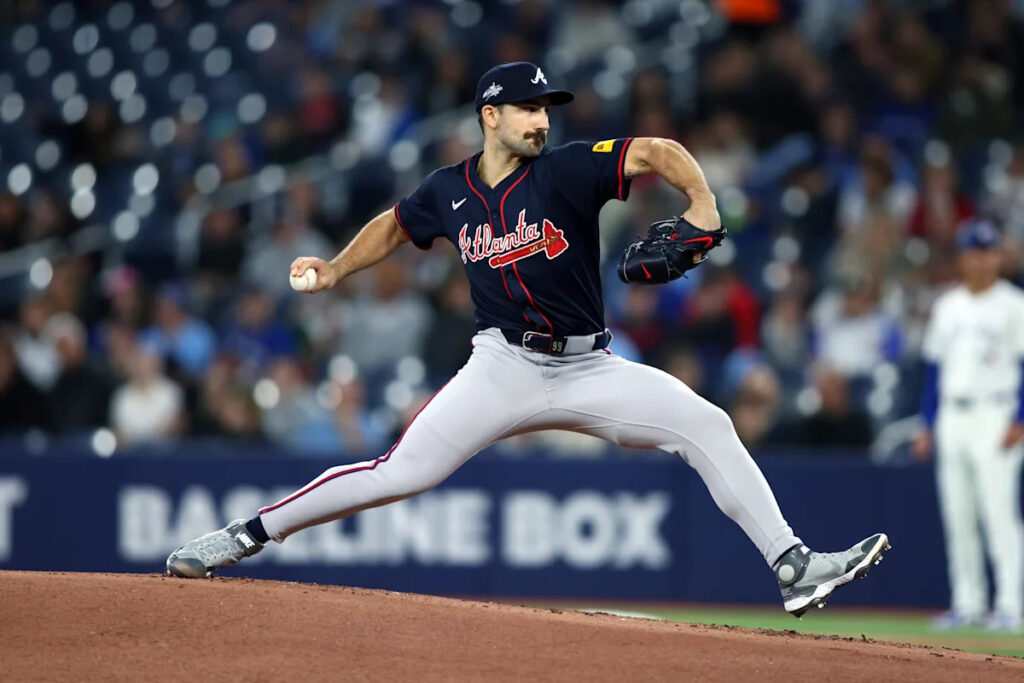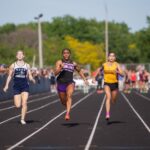For the first time in 376 days, the most unhittable starting pitcher in MLB history climbed a big-league mound.
Spencer Strider, he of the big legs and even bigger fastball, made his long-awaited return Wednesday afternoon. Just more than a year removed from reconstructive elbow surgery, the Atlanta Braves righty worked five innings against the Toronto Blue Jays. He tantalized and showed rust, allowing two earned runs while striking out five and earning the loss in a 3-1 defeat. Vladimir Guerrero Jr. popped him for a big fly in the sixth, which, after a walk to Anthony Santander, pushed Strider from the ballgame.
Advertisement
In 2022 and 2023, the mustachioed hurler — who recorded his 500th career strikeout on Wednesday — established himself, on a rate basis, as the greatest strikeout artist ever. Strider’s career 13.5 strikeouts per nine innings is the highest in baseball history for a starter with at least 50 starts. The second-highest tally is 11.6. With an overpowering, high-90s heater and a dastardly, ripcord slider, Strider entered 2024 primed to challenge for the NL Cy Young.
His elbow had other plans.
Feeling discomfort after just two starts, Strider underwent a procedure known as internal brace surgery on April 12 of last year, forcing him to miss the remainder of the season. Now, as is the case for any pitcher returning from significant surgery, Strider will need some runway to regain peak form. Nonetheless, let’s dive in and see what can be gleaned from his season debut.
Advertisement
Strider needed just three pitches — two heaters and a breaker — to strike out Toronto leadoff hitter Bo Bichette. There could not have been a more fitting, more Strider-esque way to reemerge: two high-carry fastballs under Bichette’s hands, followed by a sharp slider swing-and-miss off the plate away. Chef’s kiss. No notes.
Most importantly, Strider’s fastball velocity in the first inning averaged 96.9 mph. That figure is below the 97.2 mph average from his stellar 2023, but not by much. It’s a baseline benchmark and a reassuring number because it proves that the juice is still there.
But Strider failed to sustain that heat deep into the outing. That’s not particularly surprising, considering that he’s still working his way back to the best version of himself. Still, it’s notable information. After sitting 96.9 mph in the first inning, Strider’s average fastball velocity dipped gradually.
Advertisement
Multiple things can be true. This is not, in any way, a reason to worry about Strider moving forward. It is also a vital thing to keep an eye on. Unsurprisingly, Strider is a significantly more effective pitcher when his fastball is humming 96-98 than when it’s 93-95. The faster the pitch, the harder it is to hit — that’s not rocket science. But it’s particularly more poignant for a hurler such as Strider who leans so heavily on his fastball.
In 2023, Strider threw his four-seamer 58.9% of the time, the third-highest rate in MLB. That makes sense: His is a special pitch with elite carry from a low release height that makes it difficult to hit. But when the velo dips even slightly, there’s something of an exponential negative effect. At various points in his short career, Strider has tried to pitch through injuries, be them minor or major, and his numbers in those outings with diminished velocity are not good.
Still, let’s revisit this in a month if his velocity doesn’t tick up. Given Strider’s track record, the relatively speedy nature of his comeback and his outrageously impressive work ethic, it’s fair to expect him to regain and sustain the heat before too long.
Advertisement
Generally on Wednesday, Strider was able to pitch effectively through the middle of the start without his trademark fuzz. Predictably, the biggest damage came when he failed to locate the fastball. That’s what happened on Bo Bichette’s third-inning double. Braves backstop Sean Murphy wanted the pitch in, where Strider had beaten Bichette in their first matchup. Instead, Strider missed the entire length of the plate, and Bichette got his hands extended and drove one into the gap.
The same thing happened two batters later, when Guerrero roped a single up the gut to score Bichette. Murphy wanted that fastball in; Strider left it elevated in the middle of the plate. Guerrero took advantage of a missed spot in the sixth, too, driving a hanging 3-2 slider 412 feet to the upper deck in right.
Advertisement
In the postgame scrum, Strider appeared understandably unsatisfied with the performance. That energy was accentuated by Atlanta’s current schneid, with Wednesday’s loss dropping them to 5-13. Strider finding his stride is absolutely vital for the Braves, who have already lost 2024 breakout hurler Reynaldo Lopez for most of the season. Fellow 2024 injured listee Ronald Acuña Jr. should be back by early June, another obvious boost for a team desperately in need of all the jolts it can get.
But all things considered, Strider’s return was an encouraging glimpse and a wonderful reminder of just how dominant this immensely talented individual can be.
#Spencer #Strider #returns #Braves #learn #start


